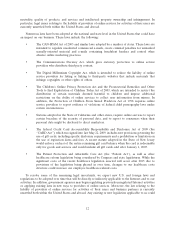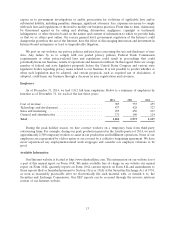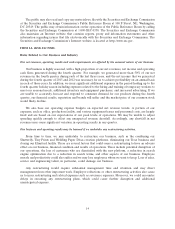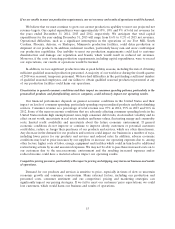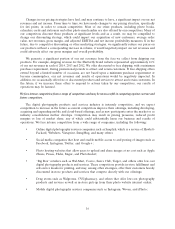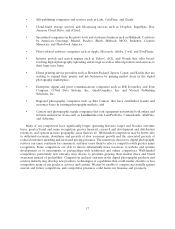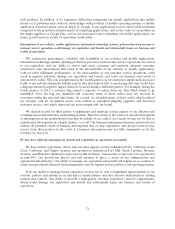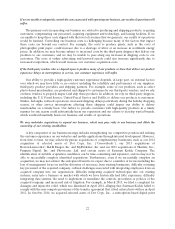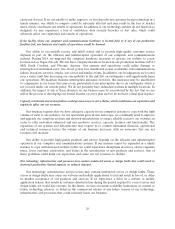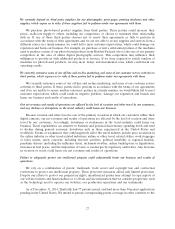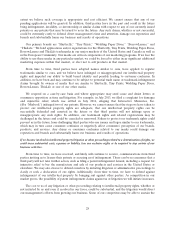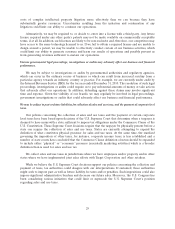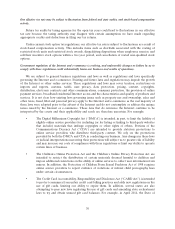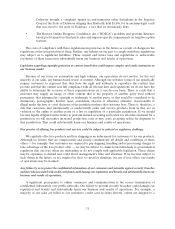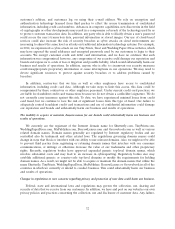Shutterfly 2014 Annual Report Download - page 23
Download and view the complete annual report
Please find page 23 of the 2014 Shutterfly annual report below. You can navigate through the pages in the report by either clicking on the pages listed below, or by using the keyword search tool below to find specific information within the annual report.If we are unable to adequately control the costs associated with operating our business, our results of operations will
suffer.
The primary costs in operating our business are related to producing and shipping products, acquiring
customers, compensating our personnel, acquiring equipment and technology, and leasing facilities. If we
are unable to keep these costs aligned with the level of revenues that we generate, our results of operations
would be harmed. Controlling our business costs is challenging because many of the factors that impact
these costs are beyond our control. For example, the costs to produce prints, such as the costs of
photographic print paper, could increase due to a shortage of silver or an increase in worldwide energy
prices. In addition, we may become subject to increased costs by the third-party shippers that deliver our
products to our customers, and we may be unable to pass along any increases in shipping costs to our
customers. The costs of online advertising and keyword search could also increase significantly due to
increased competition, which would increase our customer acquisition costs.
If the third-party vendors who we depend upon to produce many of our products or those that deliver our product
experience delays or interruptions in service, our customer experience will suffer.
Our ability to provide a high-quality customer experience depends, in large part, on external factors
over which we may have little or no control, including the reliability and performance of our suppliers,
third-party product providers and shipping partners. For example, some of our products, such as select
photo-based merchandise, are produced and shipped to customers by our third-party vendors, and we rely
on these vendors to properly inspect and ship these products. In addition, we rely on third-party shippers,
including the U.S. Postal Service, United Parcel Service and FedEx, to deliver our products to customers.
Strikes, furloughs, reduced operations, increased shipping delays particularly during the holiday shopping
season, or other service interruptions affecting these shippers could impair our ability to deliver
merchandise on a timely basis. Our failure to provide customers with high-quality products in a timely
manner for any reason could substantially harm our reputation and our efforts to develop trusted brands,
which would substantially harm our business and results of operations.
We may undertake acquisitions to expand our business, which may pose risks to our business and dilute the
ownership of our existing stockholders.
A key component of our business strategy includes strengthening our competitive position and refining
the customer experience on our websites and mobile applications through internal development. However,
from time to time, we may selectively pursue acquisitions of complementary businesses, such as our 2014
acquisition of selected assets of Dot Copy, Inc. (‘‘Groovebook’’), our 2013 acquisitions of
BorrowLenses LLC, R&R Images, Inc. and MyPublisher, Inc. and our 2012 acquisitions of ThisLife, Inc.,
Penguin Digital, Inc. and Photoccino, Ltd. and certain assets of Eastman Kodak Company. The
identification of suitable acquisition candidates can be time-consuming and expensive, and we may not be
able to successfully complete identified acquisitions. Furthermore, even if we successfully complete an
acquisition, we may not achieve the anticipated benefits we expect due to a number of factors including the
loss of management focus on and the diversion of resources from existing businesses; difficulty retaining
key personnel of the acquired company; cultural challenges associated with integrating employees from an
acquired company into our organization; difficulty integrating acquired technologies into our existing
systems; entry into a business or market with which we have historically had little experience; difficulty
integrating data systems; the need to implement or remediate the controls, procedures or policies of the
acquired company; and increased risk of litigation. For example, in March 2013, we filed a complaint for
damages and injunctive relief, which was dismissed in April 2014, alleging that Eastman Kodak failed to
comply with the non-compete provisions of the transfer agreement that it had entered into with us in April
2012. In October 2014, we acquired selected assets of Dot Copy, Inc., a subscription-based digital print
22


